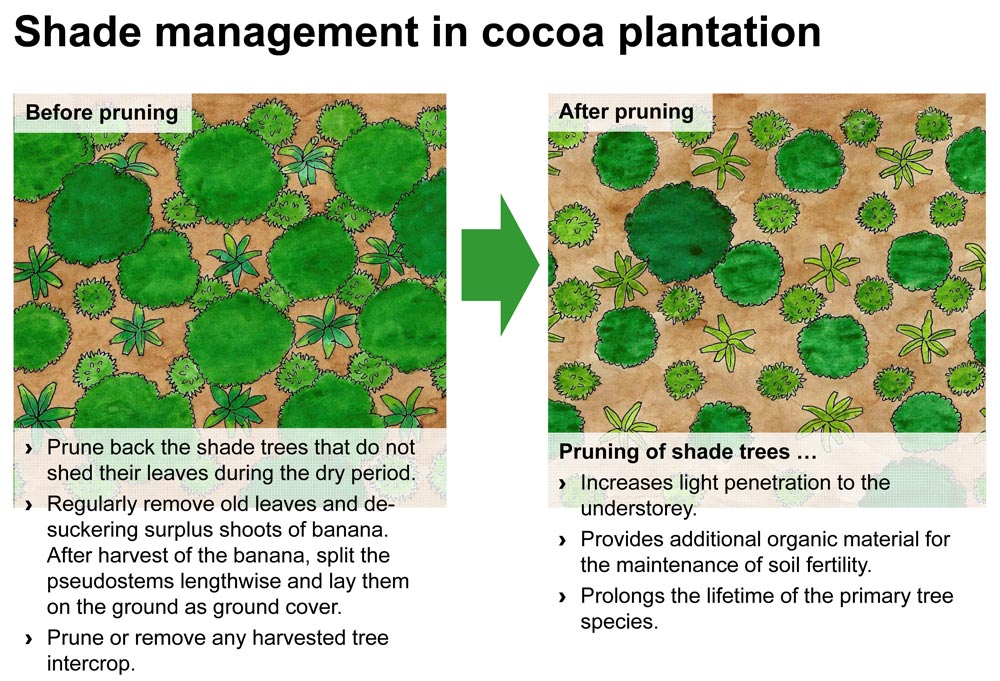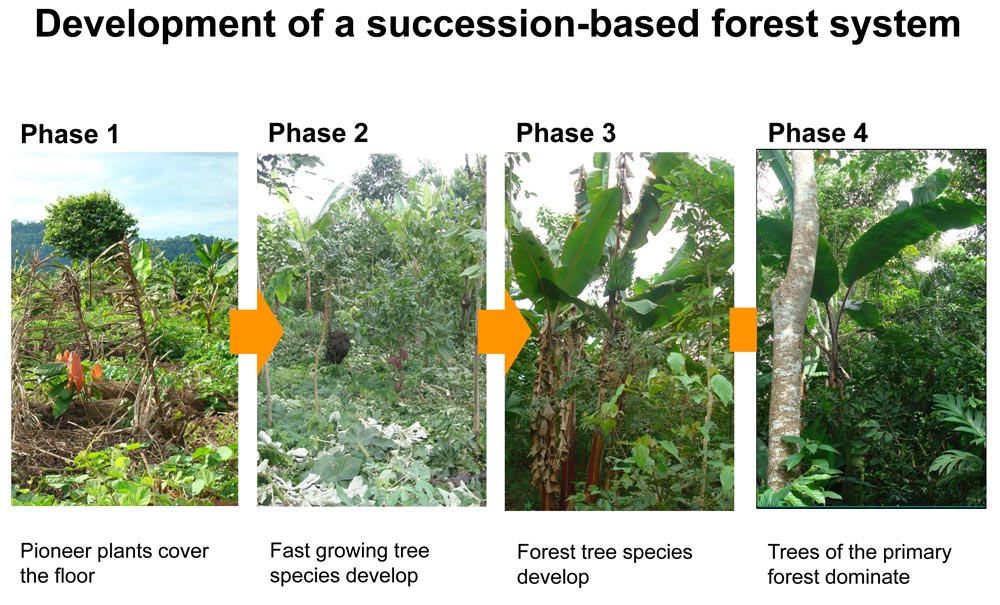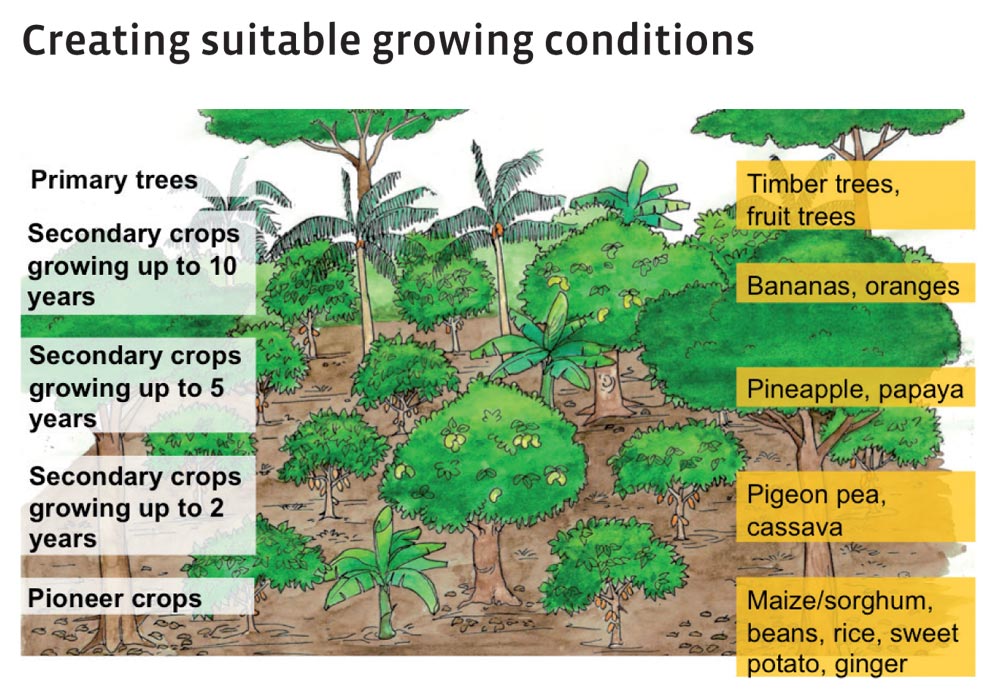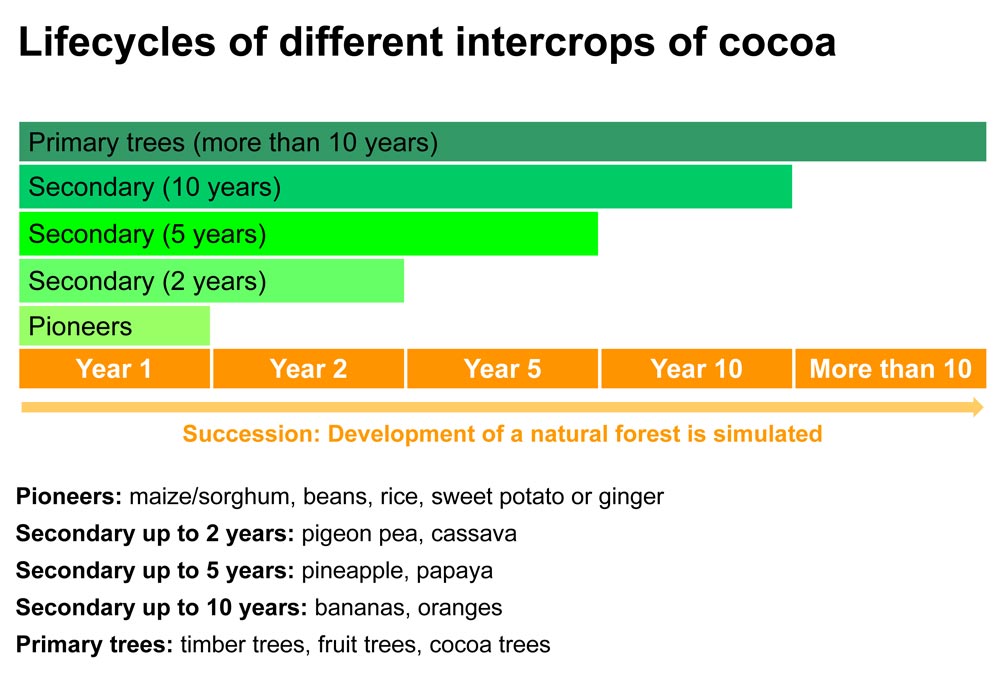Shade management

Natural forest systems have an underlying annual rhythm determined by, among other things, temperature and rainfall patterns. A number of upper storey trees of the forest system lose their foliage for some weeks or months during the dry season. In the case of cocoa, this rhythm is the more pronounced, the further away the plantation is from the equator. Thus, all the maintenance work carried out should be in harmony with the developmental rhythms of the entire system.
To further increase light penetration to the understorey plants such as cocoa, the shade trees that do not shed their leaves should be pruned back in this period.
In addition to increasing light penetration, pruning also provides additional organic material, which contributes to the maintenance and enhancement of soil fertility. Pruning indirectly improves soil texture and the abundance of earthworms. Periodic rejuvenation by pruning also prolongs the lifetime of the primary species.
If reduction of shade cover and exposure of cocoa trees to light is done about 6 months before the expected main harvest, it positively influences the generative phase of cocoa and stimulates flower formation. Rejuvenation of maturing plants enhances intensive sprouting and accelerates the rate of growth in the whole system. Bananas that are grown as intercrops between cocoa should be regularly maintained by removing old leaves and de-suckering surplus shoots. After banana harvest, the pseudostems should be split lengthwise and laid on the ground as ground cover. Any further harvested tree intercrop should be pruned or removed to contribute to increasing light penetration.
The natural habitat of cocoa trees is the tropical rainforest in South and Central
America, where the tree predominantly grows in alluvial forests within the sphere of influence of the rivers. Both the annual floods and the higher wind speeds above the water lead to a regular rejuvenation of these ecosystems. With a height of up to 9 m, the cocoa plant is a small understorey tree of the primary forest. It is associated with a vast mixture of tree species providing a stratified forest structure and a constantly high input of organic matter, when the upper storey trees such as the Cotton tree Ceiba pentandra lose their foliage for some weeks or months. The resultant higher light penetration through the canopy induces flowering of the understorey cocoa trees.
Succession-based forest system


Vital processes are very dynamic and they are subject to a permanent flow of energy, water and nutrients. In nature, these processes happen all the time and allow for the development of dynamic and stable life systems. Due to their particular climate, topography and soil, humid tropical forests are home to diverse forms of flora and fauna that respond perfectly to the conditions in the regions. The regeneration, recovery and renovation of these systems take place through succession processes. Within these processes, each species occupies, for a certain period of time, a given space, in which it contributes to improve and optimize conditions around it resulting in a diverse and more complex system. Generally, the following phases – each with its particular level in the multistorey structure – can be distinguished:
Phase 1 – Pioneer phase: Following the removal of the forest canopy, the forest floor is covered by pioneer plants within a few weeks. These pioneer species have a short life cycle of only a few months. The species composition depends on the site conditions such as soil type, slope, solar radiation and rainfall patterns.
Phase 2 – Secondary forest phase (up to 15 years): A multitude of tree species with a variety of life cycles and ultimate heights germinate at the same time as the pioneer species. This phase is characterized by some fast growing tree species dorminating the pioneers after 1 or 2 years. The dynamism of these fast growing species literally drags all the other species in the system along. The resultant high biomass production enhances soil dynamics and thus the recycling of nutrients and organic matter.
Phase 3 (up to 80 years): Secondary forest phase – medium and long cycle:
During this phase the forest tree species develop that are characteristic of the site and can reach ages of up to 80 years.
Phase 4 – Primary forest: All the preceding phases ultimately lead to the dominance of those tree species which characterize the mature primary forest with species, whose life cycle can span centuries and up to a thousand years. Mostly all of the timber tree species belong to the primary forest.
Selecting suitable growing conditions
Cocoa was originally grown under rainforest conditions, where the rainfall is high and well-distributed, with only a short dry season. A dry period is important in restricting the spread of fungal diseases, particularly the black pod disease.
But cocoa plants can tolerate longer dry periods of 3 to 4 months under balanced agroforestry conditions. However, severe shortage of water leads to leaf fall and dieback. The optimum temperature range is from 25 to 28 °C. Low temperatures below 10 °C damage the sprouting seedlings, while long periods of high temperatures above 30 °C affect the physiology of the cocoa trees. Cocoa has been successfully grown at higher altitudes near the equator, such as in Uganda at 1,400 m elevation. Strong winds can damage cocoa severely, therefore, areas that are highly exposed to such winds should be avoided.
To develop a good root system, cocoa trees require a deep soil with sufficient amounts of organic matter and good drainage. Cocoa is susceptible to longer periods of water logging and poor aeration of soils. Moderate soil pH between 5.0 and 7.0 is preferred.
Planting
Since cocoa is a shade-loving crop, all other crops to be mixed with cocoa should either be planted beforehand or at the same time as the cocoa. If the area had any natural growth, then some trees should be left standing during land preparation.
On the other hand, fast-growing trees which will rapidly provide cover, such as bananas, pawpaw or castor oil trees should be planted before cocoa is planted.
The biological activity of the soil needs to be maintained by ensuring sufficient soil ground cover so that the cocoa mycorrhiza can develop immediately.
With direct sowing, three cocoa beans are planted in the planting holes at a spacing of 1 meter. After 2 to 3 years the strongest and best formed plants are selected to continue developing. This method can be successful and requires little labour. But it requires a high quantity of seeds and bears considerable risk of rodent damage. Therefore, most cocoa is planted using nursery-raised seedlings.
In planted cocoa spacing between cocoa is commonly strongly based on traditions. Spacing can vary between 2.5 m x 2.5 m (1600 plants per hectare) and 5 m x 5 m (400 plants per hectare). The spacing of cocoa largely depends on companion crops. Although closer spacing usually produces higher yields in the first years after planting, once the canopy forms, the plantation becomes dense. Cocoa can also be planted close and thinned later. Especially under conditions of high humidity, it is advisable to thin the canopy to reduce risks of pest and disease infestations.
A moderate spacing of 3.5 m x 3.5 m or of 4 m x 4 m supplemented with regular pruning can be recommended.
Recommendations to farmers for planting:
- First, mark the planting holes with long sticks, based on the chosen spacing.
- Secondly, plant the banana rhizomes between the sticks. The planting distances for banana depend on the varieties used, the soil properties and the planting distances for cocoa. Generally between 400 and 800 rhizomes per hectare are planted.
- Tree seedlings are also sown between the banana rows. A mixture of middle and upper storey trees should be planted.
- If cocoa is to be sown directly, it should be sown at the same time as all the other plant species. If the cocoa seedlings are raised in a nursery, then planting should only be carried out when the other tree species can shade the cocoa plants.
- Planting holes only need to be big enough to allow the cocoa seedlings to be easily planted.
Establishment of a cocoa agroforestry system

By understanding and taking advantage of the principles underlying natural succession-based forest systems, abundant agricultural production can be achieved without struggling against pests and diseases. As in the forest, in a well established succession-based agroforestry system, each individual species occupies an appropriate niche and thereby fulfils a particular eco-physiological function within the system. Eventually ‘a state of dynamic equilibrium’ will be established, where overall there is little gain or loss from among the constituent species.
A dynamic agroforestry system permits a high diversity of crops with different life cycles to grow together with cocoa trees. The selection and combination of crops depends on soil characteristics, market opportunities and food preferences of the farmer. The following groups of crops can be combined or planted together with cocoa on the same day:
- Pioneers (with a growing period of several months): maize/sorghum (1 m x 1 m), beans, rice (0.4 m x 0.4 m), sweet potato (3 m x 3 m), or ginger (1 m x 1 m).
- Secondary up to 2 years: pigeon pea (0.5 m x 0.5 m), cassava (2 m x 1 m),
- Secondary up to 5 years: pineapple (0.4 m x 2 m), papaya (3 m x 3 m) or.
- Secondary up to 10 years: bananas, oranges (6 m x 6 m).
- Primary trees, more than 10 years: timber trees, fruit trees (12 m x 12 m), cocoa trees (3 m x 3 m).
Properly combined crops and trees can grow together in densities as in monocultures without any competition due to the differences in shade tolerance, life cycle and storey level.
Multiplication of planting materials
Cocoa can be planted by direct sowing or by raising seedlings from seeds or vegetative parts.
Recommendations to farmers for seedling production:
- Identify cocoa trees that have had, over several years, high and consistent yields. The trees should preferably be selected in the same region in which the plantations are going to be established. Ensure that most of the neighbouring trees are of the same type and quality, to be sure that the seeds have the same quality.
- Harvest healthy and mature pods only. Good quality hybrid seeds obtained from local research stations can also be used for seedling production.
- For the cocoa nursery make sure there is enough shade, ample water and protection from wind.
- Plant the fresh beans of ripe pods directly into black polythene bags. This is the normal practice.
- A fertile, loam topsoil is ideal for filling the bags. It is recommended to prepare a special soil mixture for the nursery composed of 40 % top soil, 30 % compost and 30 % sand. The different components have to be mixed carefully and filled into the black polythene bags. If polythene bags are not available, it is possible to use self made bags of local material such as palm leaves or banana fibres. The size of the bags should be about 10 cm x 25 cm. Relatively dense initial shade is recommended (more than 50 %). But shade must be decreased, as the seedlings grow. Apart from watering, the plants do not need much attention in the nursery. However, too much watering may promote fungus attack. Seedlings can be kept in the nursery for up to 6 months.
Recommendations to farmers for grafting:
- The seedlings are ready to be grafted with other desired varieties when they are about 50 cm in height and 8 to 10 mm in diameter.
- Scions should be selected from healthy and superior plants, which are well adapted to local conditions. Trees that show tolerance to pests and diseases are preferable.
- The length of the scions should be about 10 cm with at least 3 buds, and same size as the root stock. The scions should be harvested and collected into a resealable plastic bag after having removed all the fully formed leaves from them.
- For grafting a diagonal side-wedge is made of the scion in such a way that it just fits the diagonal side-wedge made on the rootstock stem.
- Scion and rootstock are then bound together firmly with a polythene wrap or rubber band in an upright position.
- Cover the grafted seedlings with a transparent polyethylene sheet to encourage quick sprouting of the scion.
- As soon as the buds of the scion start sprouting, slowly remove the sheet and leave the seedlings grow in a shaded area.
Choice of good varieties
Amelonado is the most cultivated cocoa type in Africa. There are, however, many cocoa varieties and hybrids. Three large groups of cocoa can be distinguished, each with several varieties and strains:
Forastero is the most widely grown type (80 % of total area under cocoa). It gives high yields, but has weak taste. The Amelonados variety is self-compatible. Criollo has a strong, fine flavour and highest cocoa quality, but the yields are low and, therefore, it is rarely cultivated. It is demanding in its habitat requirements. Trinitario is a hybrid of the Forastero and Criollo types. It is hardier and more productive than Criollo. It has a share of roughly 10 to 15 % of the total world production and can fertilize self-incompatible species of other groups.
For selection of the most suitable cocoa type and variety for the local conditions proper advice should be sought from the local cocoa farmers, extension advisors or research station. The selected varieties should be good yielding under local climatic conditions, with limited susceptibility to common pests and diseases, and produce the required quality according to the market demand.
Email: Editor@agricinafrica.com




Comments
Post a Comment